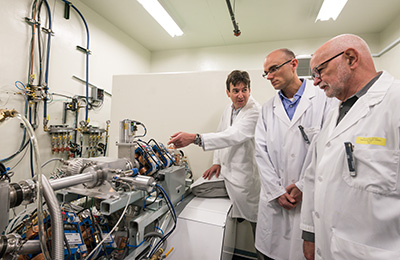On December 11, 2015, a new world record was achieved at the southern end of UBC’s campus by a big, blue, boxy machine.
The achievement – 37 quadrillion isotopes dancing on the surface of a metallic plate – wasn’t much to behold. In fact, it was invisible to the naked eye, amounting to only 6 millionths of a gram, and measurable only by the amount of gamma rays emanating from the plate.
But to the Faculty of Medicine scientists who had been working on the project, those isotopes represented a goal they had been striving toward for five years.
The particles were produced by a cyclotron, an SUV-sized device that accelerates hydrogen ions in a spiral, then strips away their electrons. The resulting protons are then channeled into a high-energy beam capable of modern-day alchemy, transforming one element into another.
In this case, the proton beam hit a plate of molybdenum, converting some of it to technetium-99m – an isotope used for dozens of types of diagnostic procedures.
The technetium-99m was nothing new; it has been used by radiologists for decades. But producing it with a cyclotron was still a novelty. And on that December day, the Faculty of Medicine and TRIUMF, Canada’s national laboratory for particle and nuclear physics, proved that a cyclotron could make enough technetium to meet the daily needs of all of British Columbia’s hospitals.
And not a moment too soon.
An alternative to aging nuclear plants
Currently, much of the technetium-based medical imaging in Canada depends on a 57-year-old nuclear power plant near Chalk River, Ont. Beset by leaks, high maintenance costs and the challenge of disposing of its radioactive waste, the federal government decided in 2009 to cease medical isotope production there by next year.
The prospect of Canada becoming dependent on a few aging overseas reactors for most of its medical imaging, and having to scramble whenever one of those plants shuts down, spurred several members of the Faculty of Medicine to pursue a long-overlooked idea: producing isotopes from cyclotrons.
Compared to reactors, cyclotrons are far smaller, more numerous, safer and easier to operate. And they have been used since the 1970s to make another medical isotope, fluorine-18, for positron emission tomography (PET) – a very sensitive imaging technology, but also quite expensive.
“With this solution, we’ll be able to make completely locally-grown isotopes, without any long-term radioactive waste.”Francois Benard, Professor of Radiology
Technetium is more of a workhorse isotope, used for thousands of scans in Canada each day – about 4 per cent of Canadians get a diagnostic examination with it each year. During technetium’s six-hour existence, it can be attached to carrier molecules and then tracked by the gamma rays it emits. The resulting images reveal whether a cancer has spread to bones, or how well blood is f lowing to the heart or brain.
Supported by grants from the National Sciences and Engineering Council of Canada, Natural Resources Canada and the Canadian Institutes of Health Research, the team of UBC and TRIUMF scientists – including Professors Francois Benard and Anna Celler and Assistant Professor Paul Schaffer in the Department of Radiology, and Thomas J. Ruth, an Adjunct Professor in the Division of Neurology – worked to modify existing cyclotron technology, overcoming various technical hurdles: designing targets that wouldn’t melt when subjected to the high-energy proton beam; securely removing the highly radioactive material from the cyclotron; and developing efficient methods of separating technetium-99m from the other elements on the metal plate.
The process of trial-and-error involved many re-thinks and adjustments, culminating with December’s demonstration, which produced enough isotopes in six hours to enable about 500 scans – beating the previous record almost four-fold.
The team, which also included scientists at Western University and McMaster University, was awarded the 2014 NSERC Brockhouse Canada Prize for Interdisciplinary Research in Science and Engineering, which honours collaborations between scientists in engineering and the natural sciences. The project also resulted in over a dozen scientific publications, several provisional patents and a training opportunity for more than several dozen students, postdoctoral fellows and engineers.
“With this solution, we’ll be able to make completely locally-grown isotopes, without any long-term radioactive waste,” says Dr. Benard, who is Scientific Director of functional imaging at the BC Cancer Agency.
Putting the solution in place
Dr. Benard expects to begin a clinical trial in Vancouver and Ontario this summer to show that cyclotron- produced medical isotopes behave the same as those from nuclear reactors. The trial will likely last about three months, involving 50 patients. If it’s a success, a cyclotron at TRIUMF would likely be put to use making medical isotopes for B.C. patients as soon as 2016.

L-R: Francois Benard, Paul Schaffer and Thomas Ruth examine the machinery that directs the proton beam. Photo courtesy of NSERC
Canada has about 23 other cyclotrons that could be adapted for this technology, and several more are expected to be put into operation in the next couple of years.
“We’ve proven the viability of producing medical isotopes on cyclotrons,” says Dr. Schaffer, who is TRIUMF’s head of nuclear medicine. “We’re now working with Health Canada to put the solutions in place.”
Many other countries are in the same situation as Canada, creating an obvious global market for this home-grown technology. A TRIUMF- affiliated company, Advanced Applied Physics Solutions Inc., is working toward licensing the technology.
“The U.K, the U.S., Japan have all expressed interest in what we’re doing,” says Dr. Ruth, a Senior Research Scientist at TRIUMF. “Smaller countries are particularly interested, because they don’t have nuclear plants, but they do have cyclotrons that could be used for this.”
